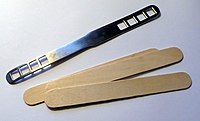
Photo from wikipedia
PATIENT A 65-year-old non-smoker man with stabilized chronic periodontitis and in good general health conditions presented to our observation. The patient reported crown mobility, gingival inflammation and localized pain, corresponding… Click to show full abstract
PATIENT A 65-year-old non-smoker man with stabilized chronic periodontitis and in good general health conditions presented to our observation. The patient reported crown mobility, gingival inflammation and localized pain, corresponding to the mandibular right first molar rehabilitated with a cement-retained implant crown. This clinical situation suspected a fracture of an implant-prosthetic component. Through the described diagnostic algorithm, an abutment hexagon fracture was revealed. Thus, a minimally invasive treatment was carried out in order to use the residual implant-prosthetic components for a new implant-prosthetic rehabilitation. DISCUSSION Fractures of implant-prosthetic components are clinical occurrences that may result in irreversible failures. The main causes of a possible fracture are dependent on biomechanical considerations and production processes of implant-prosthetic components. The respect of the rigorous planning and the employment of the implant-prosthetic devices of the same manufacturer are recommended. CONCLUSIONS Specific employments and protocols have to be offered in order to manage the fractures of implant-prosthetic components. This work showed that through the described diagnostic and therapeutic algorithm, the clinician can be guided towards a proper diagnosis and a correct management of the cases where a fracture of implant-prosthetic components may occur.
Journal Title: Journal of prosthodontic research
Year Published: 2018
Link to full text (if available)
Share on Social Media: Sign Up to like & get
recommendations!